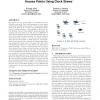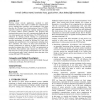38 search results - page 5 / 8 » Lazy Consistency Using Loosely Synchronized Clocks |
TMC
2010
13 years 6 months ago
2010
We explore the use of clock skew of a wireless local area network access point (AP) as its fingerprint to detect unauthorized APs quickly and accurately. The main goal behind usi...
ICCD
1992
IEEE
13 years 12 months ago
1992
IEEE
Asynchronous or self-timed systems that do not rely on a global clock to keep system components synchronized can offer significant advantages over traditional clocked circuits in ...
WECWIS
2006
IEEE
14 years 1 months ago
2006
IEEE
The paper assumes that business interactions between trading partners are composed of well defined conversations (tasks), such as issue a purchase order, process payment, refund m...
SENSYS
2004
ACM
14 years 1 months ago
2004
ACM
Wireless sensor network applications, similarly to other distributed systems, often require a scalable time synchronization service enabling data consistency and coordination. Thi...
DAC
2008
ACM
14 years 8 months ago
2008
ACM
This paper discusses the use of networks-on-chip (NoCs) consisting of multiple voltage-frequency islands to cope with power consumption, clock distribution and parameter variation...


